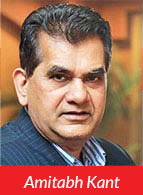 ONE of the most powerful drivers of the programme has been the focus on leveraging technology, realtime data and a robust monitoring and evaluation mechanism. Under the ADP, Key Performance Indicators (KPIs) have been identified on which progress is monitored on a realtime basis through the Champions of Change’ platform. This enables government officials to make the requisite course corrections in Programme implementation. It also spurs competition among districts by allowing them to regularly assess their position vis-à-vis other Aspirational Districts as well as the best performing district in the country. A baseline ranking of all Aspirational Districts was released by NITI Aayog in April 2018 based on published data of 49 indicators. The KPIs were identified following detailed consultations with relevant government ministries and knowledge partners.
ONE of the most powerful drivers of the programme has been the focus on leveraging technology, realtime data and a robust monitoring and evaluation mechanism. Under the ADP, Key Performance Indicators (KPIs) have been identified on which progress is monitored on a realtime basis through the Champions of Change’ platform. This enables government officials to make the requisite course corrections in Programme implementation. It also spurs competition among districts by allowing them to regularly assess their position vis-à-vis other Aspirational Districts as well as the best performing district in the country. A baseline ranking of all Aspirational Districts was released by NITI Aayog in April 2018 based on published data of 49 indicators. The KPIs were identified following detailed consultations with relevant government ministries and knowledge partners.
These are primarily socio-economic outcomes in health and nutrition, education, agriculture and irrigation, financial inclusion, skill development and basic infrastructure. To empower field officers, a primer was prepared mapping the 49 KPIs with existing schemes and listing specific actionable steps for improving the district’s performance on every indicator.
The districts are ranked on the basis of improvements from the baseline and the latest ranking on progress (delta) every month is announced by NITI Aayog. This helps to ensure that the rankings are not biased towards historical accomplishments, or lack thereof.
For young officers like District Collectors this real-time monitoring also serves as an incentive to go beyond their call of duty as they are able to show tangible results during their tenure in a district itself.
Capacities have been built on ground through continuous demand based online trainings of field functionaries on critical data literacy aspects of governance. These include trainings in use of data analytical tools, as well as improvement of formative understanding of indicators in the larger context of SDG goals.
In 35 of these districts, in partnership with the Ministry of Home Affairs, the NITI Aayog has operated a closely monitored Fellowship programme that supported the District Collectors with bright, young and motivated early career professionals in acting as change catalysts in stimulating the development process in these areas.
I am particularly happy to narrate the story of Banka, an aspirational district in Bihar. Keeping the importance of education as the prime driver of development, ‘Unnayan Banka’ is an initiative that envisages ‘quality education for all’, using the latest technologies. It is a multiplatform model in which students are getting modern day, animated, contextualised and comprehensive videos on various technology platforms like LCD/LED TVs, projectors, laptops and especially on mobile phones.
Shifting from the traditional model of education of chalk and talk, Unnayan is reinventing education using technology. The model is based on the principle of 24*7 availability of learning material. The use of mobile phones due to their immense penetration is guaranteeing quality education on mobile platforms, making it an ‘Anytime Anywhere’ model that is popularly referred to as ‘Mera Mobile, Mera Vidyalaya’. The initiative is connecting students across the nation with quality educators, with five lakh+ learners and 5,400+ educators with pan India reach and is growing by the day. In Banka, learning outcomes shot up from 17 per cent to 54 per cent and attendance rates of 90 per cent plus were achieved. Following the success of this solution in Banka district, the model has now been successfully implemented in all districts of Bihar and other aspirational districts.
The founding values as well as the implementation roadmap of the Programme have been widely appreciated at national and international levels. In June 2021, United Nations Development Programme (UNDP) in India released an independent appraisal report on the programme.
Titled “Aspirational Districts Programmeme: An Appraisal”, the report touts the Programme as a global example in leveraging local structures of governance and bureaucracy, with multi-stakeholder partnerships, to ensure that localisation of the sustainable development goals becomes a reality. UNDP marks the Aspirational Districts Programme as a model replicable not just within India, but also on a global scale. The UNDP appraisal draws from robust methodologies of qualitative as well as quantitative research. On-ground interviews with district magistrates and collectors, Prabhari officers, knowledge partners, development partners and Aspirational District Fellows form the crux of this research. Some of the District Magistrates of districts outside the purview of ADP have also been interviewed to draw a comparative analysis.
At the grassroots level, the Programme is actively powered by these stakeholders, most of them young, dynamic and driven Indian citizens, imparting a bottomup collaborative approach to the execution. The convergence and collaboration of these stakeholders ensure that the implementation of the Programme synthesises inputs, synergises efforts and expedites results. Real-time monitoring of all 49 indicators across the five focus areas on the Champions of Change dashboard, with a monthly ranking of the best performing districts, adds a competitive zeal to the programme, motivating the districts to push themselves to outperform others. This is not the first such international recognition of the success of the programme. In September 2020, a similar study was released by the Institute for Competitiveness, titled An Assessment of Aspirational Districts Programme. Acclaimed Harvard Business School Professor Michael E. Porter and MIT Professor Scott Stern in the foreword of this assessment lauded the programme’s model of active collaborations among multiple levels of governance within each district, and the use of public-private partnerships. The stakeholder-oriented approach, driven by the use of outcome-oriented metrics and data was greatly praised by the two academics.
Aspirational Districts are working towards formulating strategies for saturation of indicators. Special focus is being placed real time, as I write, on sectors like health, nutrition and education to recover lost ground due to the pandemic.
Further, governance mechanisms in challenging districts are being strengthened. For instance, analysis has shown that districts perform better when the tenure of key officials like the District Magistrate, Chief Medical Officer, District Agriculture Officer and District Education Officer, among others, is stable. Efforts are also being made to ensure that vacancies for these key positions are regularly filled by state authorities.
Finally, emphasis must be placed on extending the ADP template to under-developed blocks as well as other districts in the country which are lagging behind in social indicators. The Aspirational District Programme is successfully demonstrating that India needs to formulate policies and programmes which are grounded in data and for this we are continuously working towards significantly improving our data gathering capabilities. Secondly, we are also breaking departmental silos and converging government programmes. Thirdly, competition, ranking and putting ranking in public domain is leading to radical improvement in performance levels.
It is an experience to cherish, especially to witness the exceptional leadership of teams and individuals in these small pockets of India which are no more aspirational; rather inspirational. Across these 112 districts, people are adapting and contextualising national level institutions, frameworks and schemes spanning over education, health, nutrition, basic infrastructure and ways. There are many invaluable lessons to keep learning in policy making, innovation, quick thinking, overcoming adverse challenges and problem solving from the Aspirational Districts Programme textbook.














 G20 podium
G20 podium

